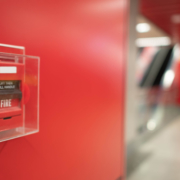UNDERSTANDING INSPECTIONS AND MAINTENANCE FOR YOUR BUILDING
Wowsers! You don’t have to worry about inspections anymore
Did you know that the fire department responds to a fire somewhere in the nation every 24 seconds? The numbers of fires and fire deaths have decreased since the 1970s, largely due to advancements in fire technology and quickened response time. With this being said, it’s important that your fire protection systems remain up to inspection and testing standards provided by the National Fire Protection Association (NFPA).
Here at VFS, we are the Inspector Gadget for your fire protection systems. We find what’s not working and we help fix it. Here are a few things you need to know as you look to ensure your fire protection systems remain up to date with their inspection and testing.
What items need to be inspected and maintained? How often?
Quarterly Inspection and Maintenance
There are a few fire protection systems that require quarterly regular inspections—mainly fire sprinkler systems. Fire sprinkler systems need to be inspected and maintained on a quarterly basis. This inspection and maintenance includes inspection of water flow devices, wolves, valve components, low air pressure alarms, and other components of your fire sprinklers.
Semi-Annual Inspection and Maintenance
Twice a year, your kitchen suppression systems need to be inspected (that is, if your facility has a kitchen). In addition, if your facility uses magnetic door locks, these must be inspected twice a year to ensure they remain operating correctly in the event the fire alarm is activated.
Annual Inspection and Maintenance
Most of your fire protection systems need to be inspected and maintained annually. These inspections will be your most comprehensive and intensive inspection periods for fire alarms, fire suppression, and bi-directional amplification systems.
In this annual inspection, over 20 components of your fire alarm systems will be tested and inspected. The major components include:
- Control panel and component inspections
- Fuse, LEDs, and power supply inspections
- Component battery replacement
- Pull station inspection
- Voice/alarm communication system inspection
Your fire sprinkler systems will also be inspected during this time. These inspections also include 20 major components of your sprinkler systems. The major components include:
- Main drain
- Antifreeze solutions
- Hose valves
- Pump system
- Drain test
Long-Term Inspection and Maintenance
There are a few components and systems that require long-term maintenance and inspection. Some of these components include fire alarm audibility testing, which should be performed every three years. In addition, fire extinguishers are scheduled for replacement every six years. Hood suppression systems in kitchens have multiple components that will need to be replaced every 12 years.
Fire Safety Inspection Requirements
Requirements for fire safety inspections vary state-by-state. Therefore, business owners and property managers need to be familiar with individual state fire codes, ordinances, and standards, and how to comply with these requirements. In general, some specific industries require more frequent fire safety inspections. These facilities include places of public assembly; including theaters, nightclubs, hotels, and hospitals. High-rises also need to adhere to strict fire code requirements, as these buildings have high occupancy and complex exit plans.
Are you prepared for your fire safety inspections?
Preparing for your fire inspections is essential—especially if you’re in the industries that are subject to unscheduled inspections. In order to prepare properly, you need to know how inspectors evaluate your building.
Let’s start with what inspectors are evaluating as a whole
As inspectors go through your building, they look for a few key things; including:
- The ways fire could start within your specific building.
- Safety systems in place, like smoke alarms, fire extinguishers, and sprinkler systems. They ensure these systems are regularly maintained and in good working order. You should expect to be asked to see documentation on the regular maintenance of these systems.
- Systems assisting in fire egress are working effectively, like lighted exit signs and exit doors.
- Lastly, inspectors ensure emergency personnel have easy, immediate access to the building.
As you look to prepare for your inspections, here are a few steps you can take to make sure they occur without any issues
Collect copies of previous inspection reports and proof of system service and inspections.
When you show up with all of your inspection reports and proof of inspections ready to go, you signal to the inspector that you take your fire protection seriously. Ensure your documentation illustrates the steps the company has taken to address previous violations.
All paperwork must prove licensed professionals have serviced your fire alarms, fire extinguishers, sprinkler systems, and fire pumps within the required timeframe are collected and kept to show your inspector.
All appointments need to be scheduled for outstanding safety systems maintenance.
Inspection, testing, and maintenance of your fire safety equipment is complex and should be outsourced to a licensed contractor and trained professionals. At VFS, our team is ready to assist you in your inspection and maintenance needs.
Make appointments for outstanding heat systems maintenance
Appliances that generate heat should be regularly maintained. These include boilers, furnaces, radiators, stoves, ovens, and other heat-producing manufacturing equipment.
Protect special hazards
Special hazard protection is essential to keep up with for your safety. Some special hazards include gasoline pumps, computer server rooms, chemical storage areas, and other places with a high concentration of flammable or combustible materials. To ensure these hazards remain protected, you must ensure your maintenance and inspection schedules are up to date.
Clear hallways and stairwells
Proper means of fire egress are essential to the safety of your building. Businesses who fail their fire inspections typically do so because they have not provided adequate means of egress. Stairways, corridors, and hallways leading to the exit should remain clear of obstructions. Stairways and corridors should also include fire doors and latch release mechanisms.
Be mindful of hazardous material storage
Combustible and flammable materials should be stored at a certain distance from the ceiling in approved containers. Do not store them in the room where heat is produced, or near appliances that produce heat.
Incompatible materials, like ammonia and bleach, should also be stored separately. Usually, they must be at least 20 feet away from each other or separated with a noncombustible partition that extends at least 18 inches above and beyond the incompatible substance.
Ensure easy and efficient entrance for the fire department
As you walk through your building, ensure all exits that emergency personnel utilize are free of obstructions. You should also ensure your address numbers are clearly marked and can be seen from the road. In order to provide safe and immediate access to your building, most businesses provide a fire department lockbox on the exterior of the building.
Label and maintain electrical system components
Electrical panels should have circuits properly labeled. These panels should have a clear space of 30 inches in front of them, so employees can reach them easily and be shut off in the event of an emergency. All electrical outlets and circuit panels should also have plate covers for safety.
ENSURE COMPUTERS HAVE POWER STRIPS AND EXTENSION CORDS ARE USED PROPERLY
Extension cords should be kept in good condition. Ensure you and your employees do not use extension cords that are split or frayed. You should also verify all computers are plugged into a surge projector with built-in circuit breakers. Circuit breakers help reduce the risk of electrical fires.
TEST EXIT SIGNS AND EXIT LIGHTING
Exit signs and emergency lighting must work properly on regular power and backup power. These signs and lights are essential to ensuring your employees escape the building safely in case of a fire.
ENSURE FIRE EXTINGUISHERS ARE IN EASY-TO-ACCESS AREAS
First and foremost, ensure you have enough fire extinguishers to cover the square footage of your building. Fire extinguishers should be clearly marked and easy to access by employees and guests in the building.
ENSURE SPRINKLER HEADS HAVE PROPER CLEARANCE
Sprinkler heads should have 18 inches of clearance. The space required for overhead sprinklers is designed to help sprinkler systems distribute water effectively in a fire. Any building that is not protected by sprinkler systems requires a minimum of 24 inches of clearance from ceiling to storage.
MAKE SURE YOU HAVE PROPER SIGNAGE THROUGHOUT YOUR BUILDING
Signage including the best escape routes should be posted in all the main areas of the building. The front door should be unlocked at all times when occupants are in the building. Additionally, ensure you have proper signage by the door to inform all employees. Maximum occupancy signage should also be posted in rooms designated for assembly. Lastly, signage reminding people to use the stairs during an emergency should be posted near elevators.
YOUR PARTNER IN INSPECTIONS AND TESTING
At VFS, we partner with our clients to ensure their maintenance and inspections are scheduled and performed regularly. The expert team at VFS Fire & Security Services has the breadth of knowledge to provide all regular scheduled and code-mandated fire protection system inspections. We have a diverse team of experienced fire protection professionals, capable of inspecting and servicing even the most complex fire protection systems.
Our advanced platforms and highly trained dispatch team allow us to manage inspections and testing from inception to execution. We tell you what’s due when it’s due, and why it’s due, and we constantly communicate to your team to keep you up-to-date on the latest information within your facilities. Allow us to be your trusted Inspector Gadget, and take on all your inspection and maintenance needs.














